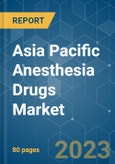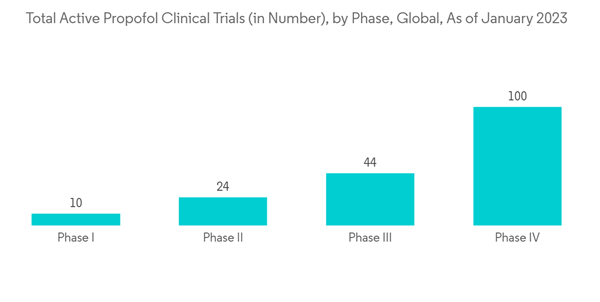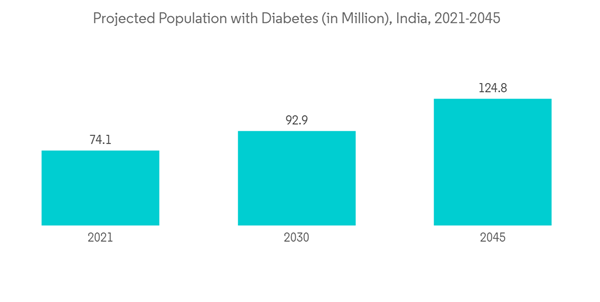The market for anesthesia drugs in Asia and the Pacific is expected to register a CAGR of 5.9% over the next few years.
COVID-19 impacted the growth of the anesthesia drugs market in the region. Surgery postponements or cancellations that occurred during the pandemic resulted in a modest drop in anesthetic drug demand. For instance, according to an article published in NCBI, in May 2020, about 5.8 lakh elective surgeries were postponed in India due to lockdown and other restriction measures imposed by the government. Thus, the delayed elective surgery cases impacted the demand for anesthesia drugs in the region during the pandemic. However, with the released restrictions, the number of surgical procedures resumed, which increased the demand for general and local anesthesia drugs. Thus, the studied market is expected to bounce back to its full potential in the coming years.
Factors such as the increasing geriatric population, a rise in the number of surgical procedures requiring anesthesia, the rising number of patients due to chronic diseases, and growing anesthesia product approvals are boosting market growth.
The rising prevalence and incidence of chronic diseases among the population, coupled with the increasing geriatric population, is the key factor driving the market's growth. For instance, according to the Australian Bureau of Statistics, in March 2022, the prevalence of heart disease in Australia was 4.0%, down from 4.0% in 2020-2021, which equates to about 1 million people. Also, according to the 2022 statistics published by UNPF, about 68% of the population living in Asia-Pacific was aged between 15 and 64 years old in 2022, and 9% of the population was aged 65 years and older in 2022. Thus, the increasing burden of cancer and heart disease increases the need for surgical procedures, which in turn is anticipated to fuel the demand for anesthetic drugs. This is anticipated to drive market growth over the forecast period.
Additionally, the increasing number of surgeries raises the demand for anesthetic drugs, which in turn is expected to fuel market growth. For example, Hexahealth published a report in October 2022 estimating that 60,000 bypass surgeries are performed in India each year.According to a study published in the Journal of Orthopaedic Science, by 2030, approximately 4,052 knee arthroplasties will be performed on men between the ages of 40 and 64, 6,942 on men between the ages of 65 and 74, and 14,986 on men over 75 in Japan.In addition, as per the same source, about 7,092 knee arthroplasty procedures are expected to be performed on women between the ages of 40 and 64 years, 22,957 on women between the ages of 65 and 74 years, and 58,340 on women over 75 years in Japan by 2030. Thus, the expected increase in the number of surgical procedures raises the demand for local and general anesthesia during surgical procedures, which in turn is anticipated to bolster the market's growth over the forecast period.
Therefore, owing to factors such as the increasing geriatric population, growing number of surgical procedures, and high burden of chronic diseases, as well as increasing product launches, the studied market is expected to grow over the forecast period. However, the side effects of general anesthesia and strict government regulations regarding product approvals are likely to impede the growth of the anesthesia drugs market in the Asia-Pacific region over the forecast period.
Propofol is a short-acting drug that causes a lower state of consciousness and impairs recollection of past experiences. It can be used for procedural sedation, beginning and maintaining general anesthesia, and sedating people who are mechanically ventilated. Propofol is one of the most commonly used general anesthetics in surgeries and is used as a sedative for critical care (including for those with COVID-19) in the ICU.
Additionally, according to an article published in BMC Anesthesiology in August 2022, it has been observed that ciprofol is a propofol analog with improved pharmacokinetic properties. In addition, ciprofol is equally as effective as propofol and is linked to fewer side effects when used to induce general anesthesia in patients undergoing gynecological surgery. Also, as per an article published in the British Journal of Anesthesia in July 2021, it has been observed that propofol is the most commonly used sedative for gastroscopies (61.0%) and colonoscopies (60.4%). Such research studies show the higher adoption of propofol and its analog during surgical procedures, which is anticipated to fuel segment growth over the forecast period.
Also, the growing number of clinical trials is likely to lead to more surgeries using propofol, which will help the growth of the segment.For instance, in October 2022, Sir Ganga Ram Hospital, India, will conduct a Phase IV clinical trial to evaluate propofol dosing based on total body weight in obese patients receiving total intravenous anesthesia. Also, in December 2022, Xiaobo Yang, in collaboration with Wuhan Union Hospital, will conduct a Phase II clinical trial to evaluate the efficacy and safety of Fospropofol disodium versus propofol for sedation in mechanically ventilated ICU patients.
Because of things like more research studies and more clinical trials, the segment that has been studied is expected to grow over the next few years.
The rising prevalence and incidences of chronic diseases such as cancer and cardiovascular diseases are the key factors driving the demand for anesthesia drugs in the country. For instance, as per the ICMR 2021 Report, it has been observed that the number of cancer patients in India is expected to rise from 26.7 million in 2021 to 29.8 million in 2025. Also, as per an article published in Frontiers in Cardiovascular Medicine, in December 2021, the overall self-reported prevalence of diagnosed CVDs was 29.4% for older adults aged 45 and above in India. The prevalence of CVDs was higher among older women than older men, and more than 80% of this burden is attributable to ischemic heart disease and stroke.
Similarly, according to the 2022 statistics published by the IDF, about 74 million people living in India were suffering from diabetes in 2021, and this number is projected to reach 124 million by 2045. Therefore, high blood sugar caused by diabetes can damage the nerves that control the heart and blood vessels, leading to a variety of cardiovascular diseases like coronary artery disease and stroke, which can narrow the arteries and necessitate coronary artery bypass grafting. This is expected to increase the demand for anesthesia during grafting surgery, hence bolstering market growth.
Therefore, owing to the aforementioned factors, such as the increasing number of cardiovascular diseases, cancer, and diabetes among the population, which further raise the demand for surgical procedures, the studied market is expected to grow over the forecast period.
This product will be delivered within 2 business days.
COVID-19 impacted the growth of the anesthesia drugs market in the region. Surgery postponements or cancellations that occurred during the pandemic resulted in a modest drop in anesthetic drug demand. For instance, according to an article published in NCBI, in May 2020, about 5.8 lakh elective surgeries were postponed in India due to lockdown and other restriction measures imposed by the government. Thus, the delayed elective surgery cases impacted the demand for anesthesia drugs in the region during the pandemic. However, with the released restrictions, the number of surgical procedures resumed, which increased the demand for general and local anesthesia drugs. Thus, the studied market is expected to bounce back to its full potential in the coming years.
Factors such as the increasing geriatric population, a rise in the number of surgical procedures requiring anesthesia, the rising number of patients due to chronic diseases, and growing anesthesia product approvals are boosting market growth.
The rising prevalence and incidence of chronic diseases among the population, coupled with the increasing geriatric population, is the key factor driving the market's growth. For instance, according to the Australian Bureau of Statistics, in March 2022, the prevalence of heart disease in Australia was 4.0%, down from 4.0% in 2020-2021, which equates to about 1 million people. Also, according to the 2022 statistics published by UNPF, about 68% of the population living in Asia-Pacific was aged between 15 and 64 years old in 2022, and 9% of the population was aged 65 years and older in 2022. Thus, the increasing burden of cancer and heart disease increases the need for surgical procedures, which in turn is anticipated to fuel the demand for anesthetic drugs. This is anticipated to drive market growth over the forecast period.
Additionally, the increasing number of surgeries raises the demand for anesthetic drugs, which in turn is expected to fuel market growth. For example, Hexahealth published a report in October 2022 estimating that 60,000 bypass surgeries are performed in India each year.According to a study published in the Journal of Orthopaedic Science, by 2030, approximately 4,052 knee arthroplasties will be performed on men between the ages of 40 and 64, 6,942 on men between the ages of 65 and 74, and 14,986 on men over 75 in Japan.In addition, as per the same source, about 7,092 knee arthroplasty procedures are expected to be performed on women between the ages of 40 and 64 years, 22,957 on women between the ages of 65 and 74 years, and 58,340 on women over 75 years in Japan by 2030. Thus, the expected increase in the number of surgical procedures raises the demand for local and general anesthesia during surgical procedures, which in turn is anticipated to bolster the market's growth over the forecast period.
Therefore, owing to factors such as the increasing geriatric population, growing number of surgical procedures, and high burden of chronic diseases, as well as increasing product launches, the studied market is expected to grow over the forecast period. However, the side effects of general anesthesia and strict government regulations regarding product approvals are likely to impede the growth of the anesthesia drugs market in the Asia-Pacific region over the forecast period.
Asia Pacific Anesthetic Drugs Market Trends
Propofol Segment Expects to Register a Significant CAGR Over the Forecast Period
The propofol segment is expected to witness significant growth in the anesthesia drugs market in Asia-Pacific over the forecast period owing to factors such as the rising number of surgical procedures and increasing demand for propofol.Propofol is a short-acting drug that causes a lower state of consciousness and impairs recollection of past experiences. It can be used for procedural sedation, beginning and maintaining general anesthesia, and sedating people who are mechanically ventilated. Propofol is one of the most commonly used general anesthetics in surgeries and is used as a sedative for critical care (including for those with COVID-19) in the ICU.
Additionally, according to an article published in BMC Anesthesiology in August 2022, it has been observed that ciprofol is a propofol analog with improved pharmacokinetic properties. In addition, ciprofol is equally as effective as propofol and is linked to fewer side effects when used to induce general anesthesia in patients undergoing gynecological surgery. Also, as per an article published in the British Journal of Anesthesia in July 2021, it has been observed that propofol is the most commonly used sedative for gastroscopies (61.0%) and colonoscopies (60.4%). Such research studies show the higher adoption of propofol and its analog during surgical procedures, which is anticipated to fuel segment growth over the forecast period.
Also, the growing number of clinical trials is likely to lead to more surgeries using propofol, which will help the growth of the segment.For instance, in October 2022, Sir Ganga Ram Hospital, India, will conduct a Phase IV clinical trial to evaluate propofol dosing based on total body weight in obese patients receiving total intravenous anesthesia. Also, in December 2022, Xiaobo Yang, in collaboration with Wuhan Union Hospital, will conduct a Phase II clinical trial to evaluate the efficacy and safety of Fospropofol disodium versus propofol for sedation in mechanically ventilated ICU patients.
Because of things like more research studies and more clinical trials, the segment that has been studied is expected to grow over the next few years.
India is Expected to Have the Significant Market Share Over the Forecast Period
The rising burden of chronic diseases and increasing surgical procedures are expected to drive significant growth in the Indian anesthesia market over the forecast period.In addition, the growing geriatric population in the country, who are more prone to developing cancers and cardiovascular diseases, further raises the need for surgical procedures, hence propelling market growth in India over the forecast period. For instance, according to a press release by the Ministry of State for Social Justice and Empowerment in April 2022, the population of elderly citizens is expected to rise from 137.5 million (10.1% of the total population) in 2021 to 227.4 million (14.9% of the total population) in 2036.The rising prevalence and incidences of chronic diseases such as cancer and cardiovascular diseases are the key factors driving the demand for anesthesia drugs in the country. For instance, as per the ICMR 2021 Report, it has been observed that the number of cancer patients in India is expected to rise from 26.7 million in 2021 to 29.8 million in 2025. Also, as per an article published in Frontiers in Cardiovascular Medicine, in December 2021, the overall self-reported prevalence of diagnosed CVDs was 29.4% for older adults aged 45 and above in India. The prevalence of CVDs was higher among older women than older men, and more than 80% of this burden is attributable to ischemic heart disease and stroke.
Similarly, according to the 2022 statistics published by the IDF, about 74 million people living in India were suffering from diabetes in 2021, and this number is projected to reach 124 million by 2045. Therefore, high blood sugar caused by diabetes can damage the nerves that control the heart and blood vessels, leading to a variety of cardiovascular diseases like coronary artery disease and stroke, which can narrow the arteries and necessitate coronary artery bypass grafting. This is expected to increase the demand for anesthesia during grafting surgery, hence bolstering market growth.
Therefore, owing to the aforementioned factors, such as the increasing number of cardiovascular diseases, cancer, and diabetes among the population, which further raise the demand for surgical procedures, the studied market is expected to grow over the forecast period.
Asia Pacific Anesthetic Drugs Industry Overview
Most of the Asia-Pacific countries are still developing, so the market is made up of many small pieces. These developing economies have a high number of people with unattended diseases and injuries that could be treated in hospitals. As a result, these countries have a high potential for anesthesia drugs and, hence, are highly lucrative for global players to enter the market. Hence, this region enjoys the presence of most of the global players in the market. Moreover, there are also some regional players that have also established their presence in the region. Some of the players in the market are AbbVie Inc., Aspen Holdings, Baxter International, Fresenius SE & Co. KGaA, and B. Braun SE, among others.Additional Benefits:
- The market estimate (ME) sheet in Excel format
- 3 months of analyst support
This product will be delivered within 2 business days.
Table of Contents
1 INTRODUCTION
4 MARKET DYNAMICS
5 MARKET SEGMENTATION (Market Size - Value in USD million)
6 COMPETITIVE LANDSCAPE
Companies Mentioned (Partial List)
A selection of companies mentioned in this report includes, but is not limited to:
- AbbVie Inc.
- Aspen Holdings
- Baxter International
- B. Braun SE
- Eisai Co. Ltd.
- F. Hoffmann-La Roche AG
- Fresenius SE & Co. KGaA
- Novartis AG (Sandoz)
- Piramal Enterprises Limited
Methodology

LOADING...










